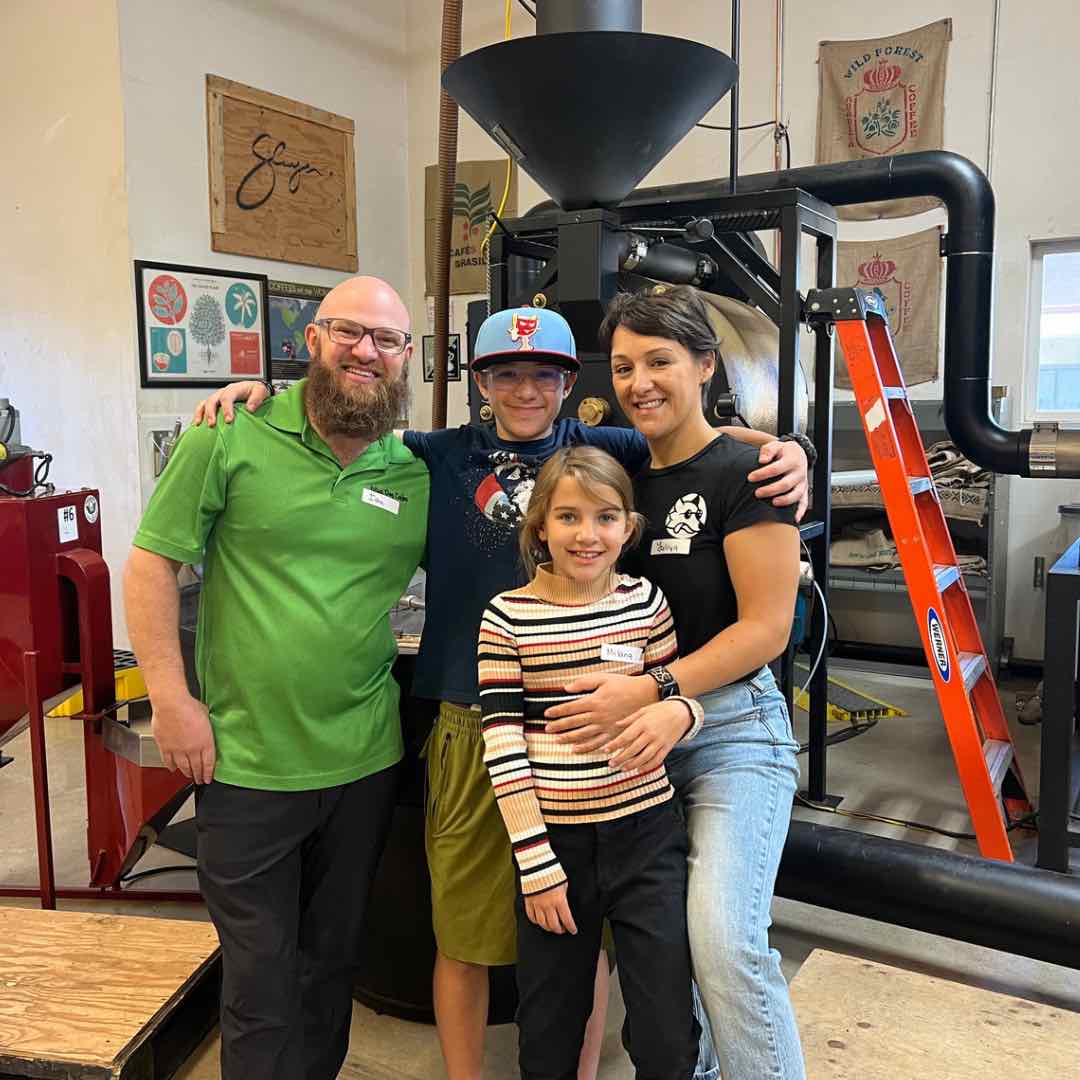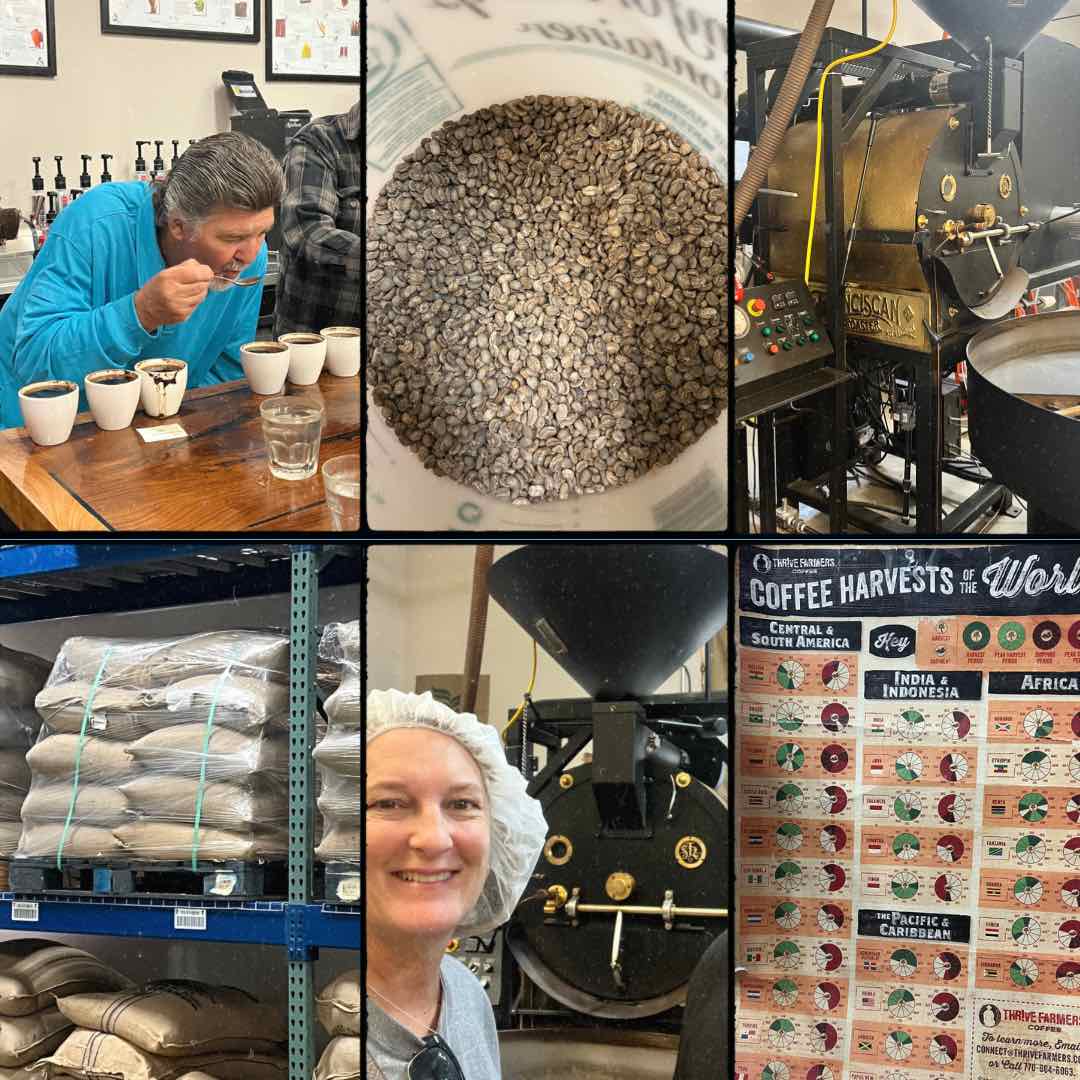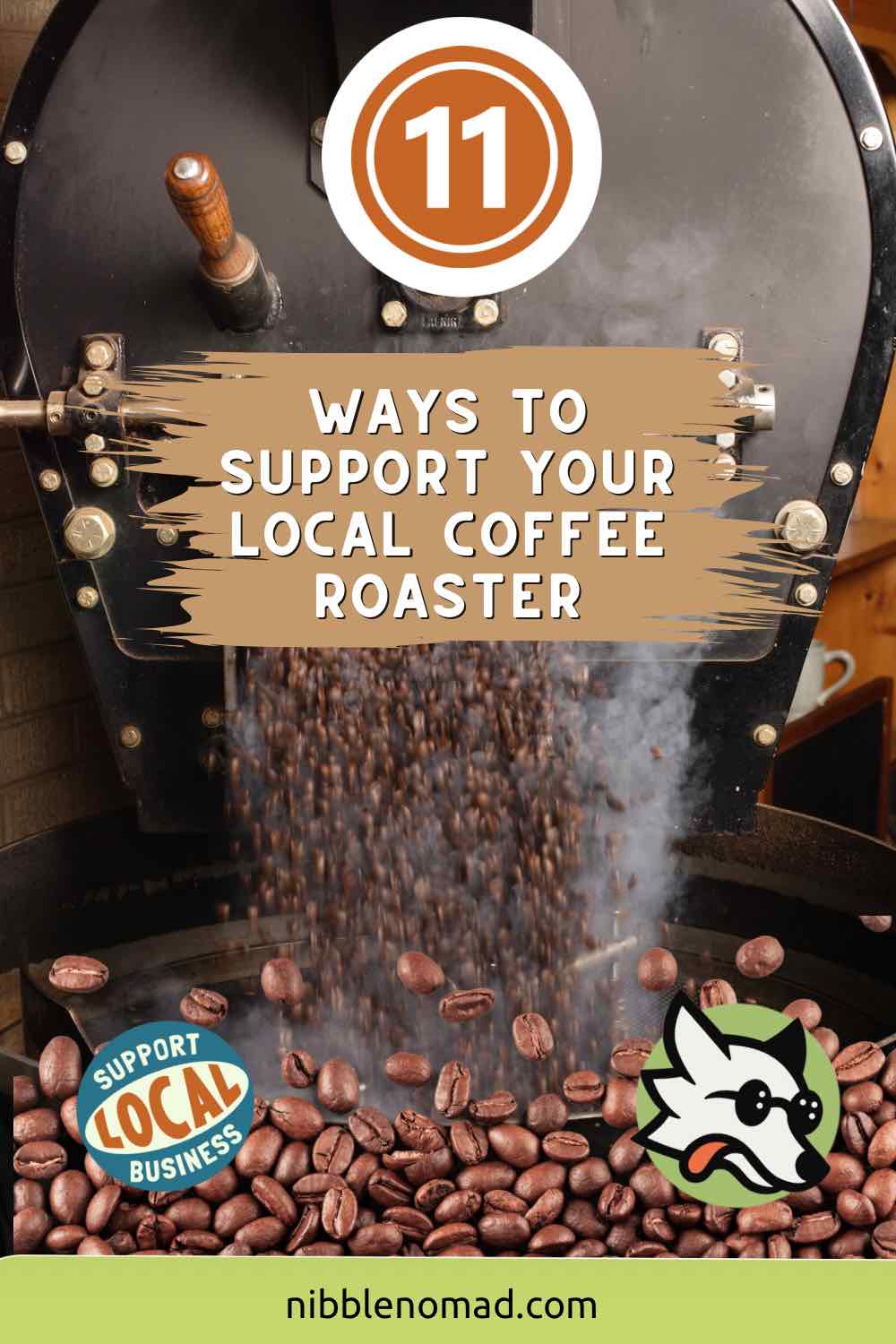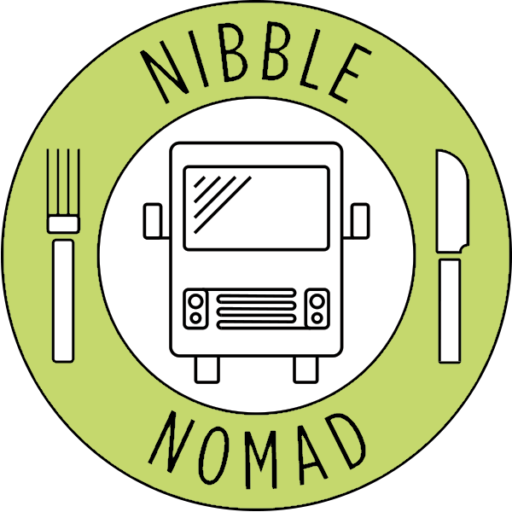Coffee is a huge part of our daily routine, so supporting the local coffee roasters in our area is the most logical thing to do for us.
We love to shop local businesses when we can.
There is most likely a coffee roaster in your area that you might not even know about. See the link below to help find a roaster close to you.
How can you support your local coffee roasters?
Buying a cup of coffee at one of your local coffee shops in your local community that promotes your favorite roasts is the easiest and most convenient way to help them. The more they receive positive feedback, the more likely they will continue to sell their locally roasted beans instead of going to the mega suppliers. Buy Local!
Here are five ways to support your local coffee roasters.
Buy their coffee – If you have a local roaster in your area, go in and buy your coffee beans at their coffee shop or roasting facility. We recently found the local roaster in the new location we moved to. We already happened to be buying their coffee, but now we know where it is roasted. It’s always best to support small businesses.
Subscribe to their coffee club – Many local roasters offer subscription services where you can receive fresh coffee beans regularly. This ensures you never run out of coffee.
Visit their coffee shop – This is a great way to show your support if they have an actual place to buy a cup of their specific roasted coffee.
Share information about the roaster on social media – You can help promote the roaster by sharing your experiences. Post pictures of their coffee and leave positive reviews on platforms like Google, Yelp, or TripAdvisor.
Attend their events – Many times, local roasters will have some social events like cupping, tastings, or workshops. By participating in these events, you will become more familiar with the coffee and the roasting process.

Cupping
Here are 5 more ways
Give their coffee as gifts – Family, friends, or work associates who like coffee would love to get some locally roasted beans for a gift. It’s a great way to introduce others to their products.
Collaborate with them- If you have a business of your own or are going to have an event, consider collaborating with your local roaster. This can be a win-win situation for both businesses.
Buy coffee equipment and merchandise – Sometimes, your local roaster will sell things like mugs, T-shirts, coffee equipment, and beans. These things make great gifts or prizes for raffles.
Go to farmers’ markets or craft fairs – Local roasters like to be a part of your area’s craft fairs and farmers’ markets. Try to stop by their booth and grab a bag of coffee or other merchandise.
Join their loyalty programs – These kinds of loyalty programs usually offer discounts and rewards to repeat customers. If you really like their coffee, it’s a perfect way to save money and never run out of beans.
And lastly, tell your friends and family – What better way to help your local roaster out than to talk about them with your friends? Let them try it, and show them all the merchandise you have.
Our local coffee roasters
We are lucky enough to have wonderful local coffee roasters in the next town over.
Blind Dog Coffee is a family-owned company in the town of Gardnerville, Nevada.

They are a small facility in the middle of a cute little town in Nevada. With only ten employees, they produce hundreds of bags of coffee daily.
We recently went to a cupping event they had over the weekend. It was so fun and interesting. We were able to learn more about the flavor profiles, and the process, from roasting the beans all the way to enjoying a great cup of coffee.
Paul and I have always bought their coffee in the local grocery store but now realize that there is so much more to this company with selections not available at that store.
The variety of blends and tastes is incredible, from regular roast to bold and robust flavors to specialty products during the holiday season, and more.
I don’t happen to drink caffeinated coffee, so Paul participated in the cupping event to smell and try all the different roasts. They weren’t sampling any decaffeinated that day, but they were kind enough to brew a cup for me so I could join in on all the fun.

More about them
The owners, Ian and Yulia, and their kids have made a name for themselves in the coffee business. They only roast Arabica beans for their coffee. Arabica beans have a little less caffeine but are superior in taste.
I was excited to learn all about the Swiss Water Process they use to decaffeinate their coffee, which makes me feel better about which decaf I drink.
They are an all-organic roaster, and their coffee is available at stores across the US and can be shipped worldwide.
It’s great to have them so close to where we live. This way, it’s so easy to attend all of their events and get our regular and specialty beans that are not offered in all stores.
Here is a quick link to find a coffee roaster wherever you live or wherever you are camping.
A quick history lesson on the coffee bean
Coffee has a fascinating journey that spans centuries. It is one of the most popular and widely consumed beverages worldwide.
It’s important to understand that it’s not just the coffee itself; it’s also the cultural, social, and economic impact it has had on different societies around the globe.
Remember that buying and grinding your beans yourself will always make the freshest coffee imaginable.
Paul and I don’t really like to buy coffee from the grocery store. We don’t know anything about where the beans came from or even how they were processed. So we prefer to buy our beans or grounds from the roaster themselves.
Finding local coffee roasters in your area is easier than you think. It’s also a great way to support small businesses and enjoy high-quality, locally sourced-coffee.

| Disclosure: Please note this post may contain affiliate links. There is no additional cost to you – we earn a commission if you purchase using our links. We only link to products and companies we use and recommend.
East African coffee beans
Coffee got its start in the East African region of Ethiopia. Legend has it that an Ethiopian goat herder noticed they became more energetic when his goats ate some of the berries from a particular tree. He thought to himself, why not try the berries himself? He did and experienced the same burst of energy. Just like that, coffee was born.
Beans from the Arabian Peninsula
Coffee had spread to Yemen in the Arabian Peninsula by the 15th century. From then on, coffee houses became very popular for people to gather and enjoy coffee and conversation.
Beans in the European area
By the 17th Century, Venice started to open coffeehouses, which England and France followed. These areas were great for gatherings, discussions, debates, and intellectual conversations.
Beans come to the Americas
The coffee plant was brought to the island of Martinique in the Caribbean in the 18th century. Coffee plantations became an essential part of the economy in these areas.
Countries like Brazil and Colombia have become major areas for the coffee industry.
Beans in the Modern Era
Coffee continued to evolve with the development of different brewing methods, coffee chains, and specialty shops.
A growing concern has recently been for beans’ sustainability and ethical sourcing.
The fair trade movement has helped with working conditions and the coffee farmers’ income.
Where do most of the coffee beans come from?
Coffee is grown all around the world, where the climate and conditions are favorable.
Most coffee is grown near the equator, known as the “coffee belt.” That area is Central and South America, Africa, and Asia.
Brazil, Colombia, Ethiopia, and Vietnam are some of the most renowned coffee-producing Countries.
Coffee is grown on coffee plantations or farms. They must be grown with the right altitude, temperature, rainfall, and soil composition.
Processing the beans
Once the beans are ripened, they are harvested by hand or mechanical harvesters.
After they have been harvested, they need to be processed either by dry natural, washed, or semi-washed methods.
The beans need to be dried before they can be roasted. Once dried, the beans get milled to remove the hulls and then graded by size and quality.
At this point, the beans are now ready for export to coffee roasters and distributors.
Roasting is typically done at coffee roasteries or more extensive industrial facilities. Roasting is pretty much the most critical step because it develops the beans’ flavor and aroma. It affects the coffee’s taste, ranging from light to dark roasts.
What about decaffeinated coffee
Now, we all like the burst of energy that a cup of coffee gives us, but what if you don’t like that feeling, or there is some other reason for the need for decaffeinated coffee? Is all decaffeinated coffee the same?
Something very important to mention is that decaffeinated coffee is not entirely caffeine-free. It’s usually significantly less than regular coffee but not completely removed.
Is it safe to consume
Decaffeinated coffee is safe and usually has no adverse health effects. However, suppose you are extremely sensitive to caffeine or have a medical condition that requires you to avoid caffeine entirely. In that case, you should remember that decaffeinated coffee is not completely caffeine-free.
I love coffee, but over the years, I have realized that I have adverse reactions to caffeine. By trying decaffeinated coffee, I have learned that it isn’t the caffeine itself; it’s the amount I was drinking.
Now that I know that, I feel more confident drinking decaffeinated coffee.
The process of decaffeination
There are a few ways to decaffeinate coffee. Some are good, and some are bad.
Some of the decaffeination processes out there may use chemical solvents (such as methylene chloride or ethyl acetate). The problem with this process is that some very small traces of solvents may be left behind in the coffee. These traces are still safe to consume, but if you have concerns about chemical residues, this might not be the process of beans for you.
The water-based method of decaffeinating coffee beans is the preferred way to process the beans. This is definitely the way that I and most other decaffeinated coffee drinkers like.
This process is called the Swiss Water Process, which is often the preferred method for its naturalness and safety.
Remember that even though the coffee has been decaffeinated, it retains most of the other beneficial compounds found in regular coffee. Those are things like antioxidants and various phytochemicals.

Finally
When it comes to coffee, it can either be something that you are passionate about, or just a drink to get your day started. Try different roasters and see what appeals to you the most. It can be a fun experience.
Why not drink what you like the most and start your day with a smile?
Nibbler Tip: If you have any specific health concerns about caffeine or decaffeinated coffee, it’s always a good idea to consult your healthcare professional.

Related Post
AMAZON DISCLOSURE: This website participates in the Amazon Services LLC Associates Program, an affiliate advertising program designed to provide a means for us to earn fees by linking to Amazon.com and affiliated sites.






